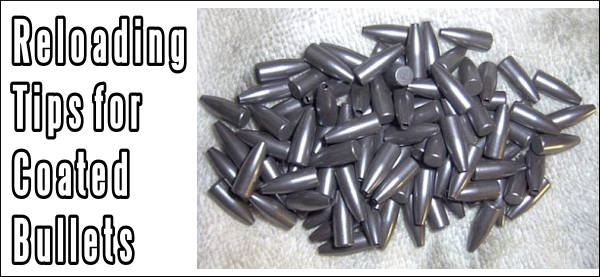Reloading Tip for Coated Bullets — Adjust Loads Cautiously

Coating bullets with a friction-reducing compound such as Molybdenum Disulfide (Moly) offers potential benefits, including reduced barrel heat, and being able to shoot longer strings of fire between bore cleanings. One of the effects of reduced friction can be the lessening of internal barrel pressures. This, in turn, means that coated bullets may run slower than naked bullets (with charges held equal). To restore velocities, shooters running coated bullets are inclined to “bump up” the load — but you need to be cautious.
Be Careful When Increasing Loads for Coated Bullets
We caution shooters that when your start out with coated bullets in a “fresh barrel” you should NOT immediately raise the charge weight. It may take a couple dozen coated rounds before the anti-friction coating is distributed through the bore, and you really start to see the reduced pressures. Some guys will automatically add a grain or so to recommended “naked” bullet charge weights when they shoot coated bullets. That’s a risky undertaking.

Instead we recommend that you use “naked” bullet loads for the first dozen coated rounds through a new barrel. Use a chronograph and monitor velocities. It may take up to 30 rounds before you see a reduction in velocity of 30-50 fps that indicates that your anti-friction coating is fully effective.
We have a friend who was recently testing moly-coated 6mm bullets in a 6-6.5×47. Moly had not been used in the barrel before. Our friend had added a grain to his “naked” bullet load, thinking that would compensate for the predicted lower pressures. What he found instead was that his loads were WAY too hot initially. It took 30+ moly-coated rounds through the bore before he saw his velocities drop — a sign that the pressure had lowered due to the moly. For the rounds fired before that point his pressures were too high, and he ended up tossing some expensive Lapua brass into the trash because the primer pockets had expanded excessively.
LESSON: Start low, even with coated bullets. Don’t increase your charge weights (over naked bullet loads) until you have clear evidence of lower pressure and reduced velocity.
Procedure After Barrel Cleaning
If you shoot Moly, and clean the barrel aggressively after a match, you may want to shoot a dozen coated “foulers” before starting your record string. Robert Whitley, who has used Moly in some of his rifles, tells us he liked to have 10-15 coated rounds through the bore before commencing record fire. In a “squeaky-clean” bore, you won’t get the full “benefits” of moly immediately.
 To learn more about the properties of dry lubricants for bullets, read our Guide to Coating Bullets. This covers the three most popular bullet coatings: Molybdenum Disulfide (Moly), Tungsten Disulfide (WS2 or ‘Danzac’), and Hexagonal Boron Nitride (HBN). The article discusses the pros and cons of the different bullet coatings and offers step-by-step, illustrated instructions on how to coat your bullets using a tumbler.
To learn more about the properties of dry lubricants for bullets, read our Guide to Coating Bullets. This covers the three most popular bullet coatings: Molybdenum Disulfide (Moly), Tungsten Disulfide (WS2 or ‘Danzac’), and Hexagonal Boron Nitride (HBN). The article discusses the pros and cons of the different bullet coatings and offers step-by-step, illustrated instructions on how to coat your bullets using a tumbler.


















Excellent tip! Back in the day, some moly shooters used cleaning methods that were somewhat non standard. For current users, or those who contemplate using moly, a little research may be in order. On thing that I remember is that conventional petroleum based cleaners were not very good at removing moly from barrels. Given that there is a whole new crop of bore cleaners that have significantly different chemestry , it may be that going back in time a bit would be an advantage. In any case if one were to figure out how to remove powder and copper fouling without taking all of the moly out, there might be an advantage.
I used Dri-Slide on a patch to pre-coat the bore with moly after I cleaned and had excellent results.
This applied not to ‘coated bullets’ but to ‘moly coated bullets’. The other coatings used today produce different results all together.
If I had to “season” the barrel with moly for 20-30+ shots before getting any benefit, I would give up on moly.
About 30+ years ago, when moly was just starting to get the attention shooters, I didn’t have the resources to coat bullets. Instead, I swabbed the bore with a SC7/moly mix before the initial clean-bore shot. After that I would shoot naked bullets with very little, if any, copper fouling. The result (gratification) was immediate. Also, I did not notice any loss of velocity over time after swabbing. Anecdotal evidence yes, but I believe it’s solid.
Today, I coat the bullets, but still use pre-swabb the bore most of the time, especially when I plan on shooting long strings, just to be sure. There may be better things out there, but I’m sticking to what worked the first time, and ever since.
NOTE: Swabbing the bore with moly demands a consistent technique and certain precautions which I arrived at over time using trial-and-error, mostly error, but nothing unsafe.